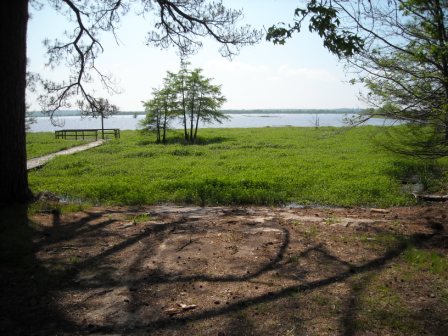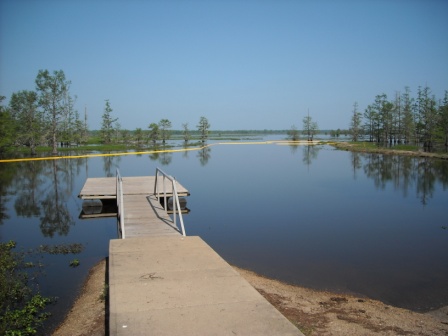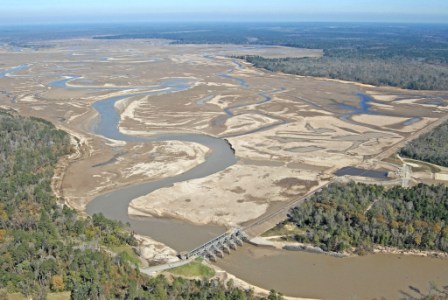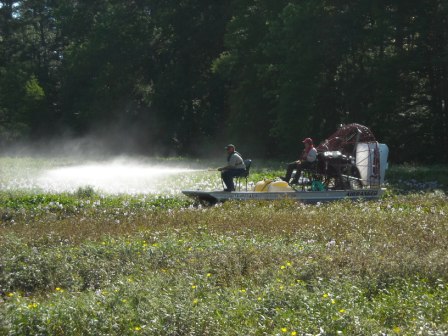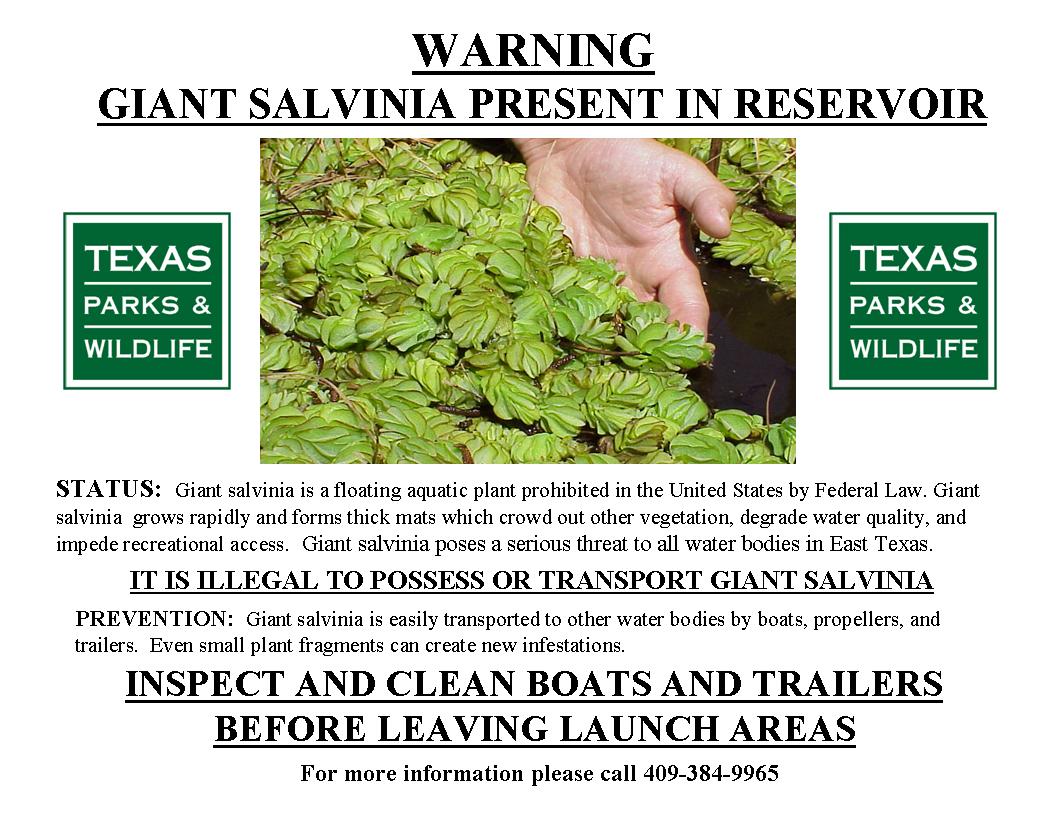Fort Worth District
Lakes and Recreation Menu
Invasive Species Page
Click on a Subject to access Information - Click "Return to Top" to return to this list
Nusiance Aquatic Species
Management Options:
Education
Nuisance Aquatic Species
B.A. Steinhagen contains several non-native invasive aquatic vegetation species which have plagued the reservoir for many years and prevent adequate access to the resource. Problematic invasive exotic species present on Steinhagen include water hyacinth, alligatorweed, giant and common salvinia, and hydrilla . Historically, water hyacinth and alligatorweed were the most invasive species in the reservoir. The arrival of common salvinia approximately 10 years ago added to extensive problems associated with invasive vegetation. The discovery of giant salvinia in 2007 poses the most serious threat to date.
In addition to the restriction of access, nuisance aquatic vegetation negatively impacts interests critical to the economy of communities and businesses both locally and downstream. The Lower Neches Valley Authority (LNVA) depends on the water stored in B.A. Steinhagen to provide water necessary for agriculture and industry. The Southwestern Power Administration depends on the water stored in B.A. Steinhagen for the generation of electricity. Excessive aquatic vegetation can significantly restrict flows during critical periods, which quickly translates into lost income and hardship for the region.
Efforts have been made over the years to control the growth and spread of nuisance vegetation in the lake and associated river system, as well as prevent the introduction of additional problem species.
Management Options
Biological Controls –
One of the problems with exotic aquatic vegetation is the lack of native species that can adequately control the rapid growth of these invasive plants. There are several species of small beetles, native to the respective regions that the problem plants come from, that feed on specific species of plants, such as water hyacinth, alligatorweed, and salvinia, and occur in adequate numbers to keep growth in check. Research is ongoing to determine the feasibility of introducing these beetles locally to help with control, but until thriving populations are established, other control measures must be implemented.
Mechanical Controls -
Wide-scale physical removal of nuisance aquatic vegetation is not practical in most water bodies, due to irregular shorelines, shallow depths, existing trees or stumps, and the sheer volume of vegetation present in most cases. Vegetation can be removed by hand in targeted areas such as beaches and boat ramps, and exclusion devices can be installed to help prevent the wind from packing floating vegetation into these areas, enabling boaters to launch/load boats without getting plants on their trailers. These devices have been installed at several ramps on B.A.Steinhagen, with more to come as funds and time allows. Please be cautious when navigating near these devices.
Magnolia Ridge Boat Ramp
Before Exclusion Device/After Installation
Drawdowns
In an effort to control the rapid growth and expansion of nuisance aquatic vegetation on B. A. Steinhagen Lake, the Corps of Engineers and Texas Parks and Wildlife conducted several partial winter drawdowns during the 1990 ’s. For a six week period in January and February, the lake was lowered 6.5’ to an elevation of 76.0’ NGVD. Expectations were that the freezing temperatures and drying winds would kill or greatly reduce coverage of the exotic plants, especially water hyacinth. These winter drawdowns had limited success (rarely encountered hard freezes with level at lowest point), and the beneficial effects seldom lasted through the subsequent growing season. In January 2010, The Town Bluff project office was able to execute a short duration partial drawdown to take advantage of the predicted bitterly cold weather that lasted 3-4 days, dropping the lake approximately 2.5 feet. This effort appears to have been highly successful and will greatly aid in controlling the spread of nuisance vegetation in 2010.In 2006 - 2007, in a cooperative effort with the Texas Parks & Wildlife Department, the Lower Neches Valley Authority, and the Southwestern Power Administration, a summer drawdown was implemented in an attempt to control the noxious aquatic vegetation that was impacting most of the lake, including the flows at the hydroelectric generators. This approach would more closely mimic a natural, seasonal water level variance, similar to what the lake experienced before the construction of Sam Rayburn Reservoir in 1965 and the R. D. Willis Powerhouse in 1989, which allowed the lake level to drop in late summer due to lack of rainfall and demands for water downstream. As the lake waters receded in June 2006, the vegetation was exposed to summer temperatures and drying winds. The Texas Department of Transportation contacted the Town Bluff Office and requested that the drawdown continue beyond the planned September 2006 ending date, giving TxDOT the opportunity to make repairs to pilings on the US Hwy 190 bridge where it crossed the lake. Also during the drawdown, surface cracks and minor voids were detected in the Town Bluff embankment and spillway, as well as a retaining wall at the floodgates that had cracked and shifted, and the opportunity was taken to address these issues. This additional work, along with contract and weather delays, extended the drawdown into the late spring of 2007. The aquatic vegetation was exposed to summer heat and winter frost, and served as a good start to the targeted spraying effort that was implemented in the 2008 growing season. Plans are to apply herbicide via airboat throughout the 2010 growing season and beyond, thanks to funding from LNVA and assistance from TPWD.
Lake level drawdowns are neither the primary nor most effective means of controlling the nuisance aquatic vegetation in B. A. Steinhagen, but they may still be utilized in the future as part of a comprehensive approach to vegetation management, especially when coordinated with planned construction or repair efforts at the project. Town Bluff will keep the visiting public informed of any future drawdown plans, so that accommodations can be made due to limited lake access during these times.
Herbicide Application
The Corps of Engineers entered into a cooperative agreement with the Lower Neches Valley Authority and Texas Parks and Wildlife in 2007 to join efforts in controlling the rampant growth of the nuisance aquatic vegetation on B. A. Steinhagen. TPWD biologists developed a working management plan, consisting of public education efforts, physical vegetation barriers where applicable, and a strategic aquatic herbicide program to combat the plants. Several broad-scale aerial herbicide applications occurred in 2007, with a lake-wide airboat application starting with the 2008 growing season. LNVA contracted with a company specializing in airboat application, which worked from May through October targeting nuisance species with great success. Efforts were focused on improving access to boat ramps, docks and park shorelines, as well as reducing the amount of vegetation collecting at the lake’s outlet works that tended to impede electric generation. By the end of the 2008 season, lake visitors saw vast improvement in access and aesthetics, and the managing agencies were encouraged that control of a number of species was possible. The program was continued in 2009, resulting in the coverage of water hyacinth dramatically reduced, and common and giant salvinia populations held in check. With the main body of the lake in a manageable condition, the spray crew was able to treat some of the more remote areas of the lake in the Wildlife Management Area on the north end, including the Forks of the Rivers and Bee Tree Slough, improving access for fishermen, hunters and nature lovers. Plans are to continue the program into the foreseeable future, reaching even farther to improve public access to the lake and restore native plant communities.Education
For more information on invasive species:
Texas Invasives
Protect Your Waters
US Fish & Wildlife Services
USDA Inavsive Species Info Center


